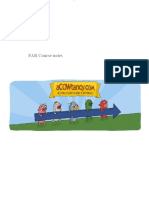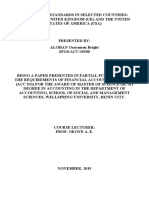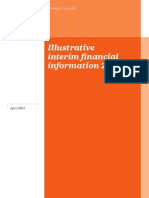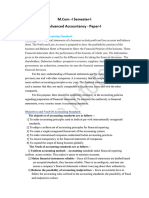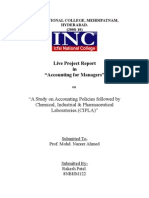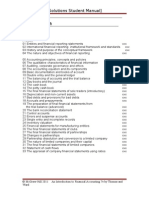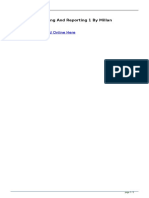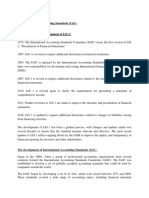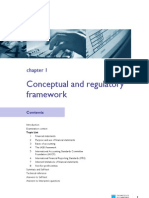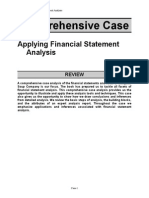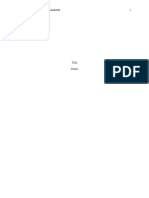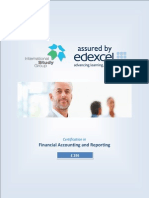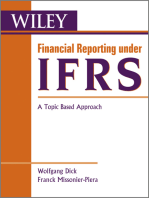A As Ias Booklet
A As Ias Booklet
Uploaded by
Bhavik ShahCopyright:
Available Formats
A As Ias Booklet
A As Ias Booklet
Uploaded by
Bhavik ShahOriginal Title
Copyright
Available Formats
Share this document
Did you find this document useful?
Is this content inappropriate?
Copyright:
Available Formats
A As Ias Booklet
A As Ias Booklet
Uploaded by
Bhavik ShahCopyright:
Available Formats
INTERNATIONAL ACCOUNTING STANDARDS CIE Guidance for teachers of 9706 A and AS Level Accounting
CONTENTS Introduction ................................................................................................................................ 3 Use of this document................................................................................................................. 3 Users of financial statements .................................................................................................... 4 Qualitative characteristics.......................................................................................................... 4 IAS 1 Presentation of Financial Statements (revised 6 September 2007) ................................ 5 Structure and content of financial statements ........................................................................... 6 Income Statement ..................................................................................................................... 7 Balance Sheet ......................................................................................................................... 11 IAS 2 Inventories ..................................................................................................................... 13 IAS 7Cash flow satement ........................................................................................................ 17 IAS 8 Accounting policies ........................................................................................................ 21 IAS 10 ...................................................................................................................................... 23 IAS 16 ...................................................................................................................................... 25 IAS 18 ...................................................................................................................................... 29 IAS 33 ...................................................................................................................................... 31 IAS 35 ...................................................................................................................................... 34 IAS 36 ...................................................................................................................................... 36 Appendix 1 - Statement of Changes in Equity .................................................................... 40 Appendix 2 Alternative format for statement of financial position (Balance Sheet) ......... 41 Appendix 3 - Financial Statements for other forms of business ......................................... 42 (a) Financial Statements (Final Accounts) of a Sole Trader Trading business................ 42 (b) Financial Statements (Final Accounts) of a Sole Trader Service business................ 44 (c) Financial Statements (Final Accounts) of a partnership business................................. 45 (d) Financial Statements (Final Accounts) of a manufacturing business............................ 47 (e) Financial Statements (Final Accounts) of a non-trading organisation ........................... 48 (f) Financial Statements (Final Accounts) of a limited company......................................... 50
2
The University of Cambridge International Examinations
Introduction This document is designed to help centres in their delivery of International Accounting Standards (IAS) to students. Its aims are: 1. To give a definitive indication of the areas students will need to be aware of in relation to IAS for future CIE examinations. 2. To provided illustrative examples for students and tutors. The guidance presented in this document is primarily aimed at teachers. Only those standards identified in the A/AS syllabus will be considered, as listed below: International Accounting Standards Candidates will be required to have a basic knowledge of the following standards and how these standards relate to topics in the syllabus IAS IAS 1 IAS 2 IAS 7 IAS 8 IAS 10 IAS 16 IAS 18 IAS 23 IAS 32 IAS 33 IAS 35 IAS 36 IAS 37 IAS 38 IAS 39 Topic Presentation of financial statements Inventories (stocks) *(not long-term contracts) Cash flow statements Accounting policies Events after balance sheet date Property, plant and equipment Revenue Borrowing costs Financial instruments: presentation and disclosure Earnings per share Discontinuing operations Impairment of assets Provisions, contingent liabilities and contingent assets Intangible assets Financial instruments: recognition and measurement FRS/SSAP FRS3 SSAP9* FRS1 FRS18 SSAP17 FRS15
FRS4 FRS14 FRS3 FRS11 FRS12 FRS10 FRS13
Use of this document The model financial statements included here are provided solely for illustrative and information purposes for you and your students - they are given to help you and your students apply the relevant standards, at the relevant level, to a course of study. Every effort has been made to ensure that these documents are complete in terms of the relevant requirements of IFRSs and IAS, but the standards are constantly changing and you should review professional documents as they become available in order to maintain current working knowledge of the standards. 3
The University of Cambridge International Examinations
Users of financial statements Financial statements are used by a variety of groups for a variety of reasons. The framework surrounding IAS identifies the typical user groups of accounting statements. The table below identifies the user groups (stakeholders) and gives likely reasons for the user groups to refer to financial statements: Main users Investors Employees Reasons for use To assess past performance as a basis for future investment. To assess performance as a basis of future wage and salary negotiations. To assess performance as a basis for continuity of employment and job security. Lenders To assess performance in relation to the security of their loan to the company. Suppliers To assess performance in relation to them receiving payment of their liability. Customers To assess performance in relation to the likelihood of continuity of trading Government To assess performance in relation to compliance to regulations and assessment of taxation liabilities. Public To assess performance in relation to ethical trading
Qualitative characteristics Financial statements are prepared for a variety of reasons. The information provided by them is useful to users. IAS sets out four qualitative characteristics of the financial statements: Understandability the information is readily understandable by users. Relevance the information may be used to influence economic decisions of users. Reliability the information is free from material error and bias. Comparability the information enables comparisons over time to identify and evaluate trends. The following sections concentrate upon the specific presentations identified by the specific IAS.
4
The University of Cambridge International Examinations
IAS 1 (revised 6 September 2007) IAS 1 changes the titles of financial statements as they will be used in IFRSs: 'balance sheet' will become 'statement of financial position' 'income statement' will become 'statement of comprehensive income' 'cash flow statement' will become 'statement of cash flows'.
The revised IAS 1 is effective for annual periods beginning on or after 1 January 2009. Early adoption is permitted. Entities (businesses) are not required to use the new titles in their financial statements but all existing Standards and Interpretations are being amended to reflect the new terminology so could be a source of confusion for teachers using recent textbooks or doing research on line.
PRESENTATION OF FINANCIAL STATEMENTS This statement covers a number of areas, including the background to the purpose of final statements, their components and illustrations of the presentation of the Income Statement and the Balance Sheet.
1.
The purpose of Financial Statements
To provide information about the financial position, financial performance and cash flows of an entity that is useful to a wide range of users in making economic decisions.
2.
The components of the Financial Statements
A complete set of financial statements as set out in the Standard, comprises: balance sheet (from 1/1/2009 a statement of financial information as at the end of .) income statement (from 1/1/2009 a statement of comprehensive income for the period) a statement of changes in equity a statement of cash flow - cash flow statement (also has to its own specific IAS) accounting policies and explanatory notes (also has its own specific IAS)
3.
Accounting Concepts
The statement requires compliance with a series of accounting concepts: 5
The University of Cambridge International Examinations
Going concern the presumption is that the entity will not cease trading in the immediate future. (This is generally taken to mean within the next 12 months.)
Accrual basis of accounting with the exception of the cash flow statement the information is prepared under the accruals concept, income and expenditure is matched to the same accounting period.
Consistency the presentation and classification of items in the financial statements is to be consistent from one period to the next. Thus the entity uses straight line depreciation one year it must do so for future years.
Materiality and aggregation classes of similar items are to be presented separately in the financial statements. This would apply to a grouping such as current assets.
Offsetting this is generally not permitted for both assets and liabilities and income and expenditure. For example it is not permitted to offset a bank overdraft with another bank account not in overdraft.
Comparative information there is a requirement to show the figures from the previous periods for all the amounts shown in the financial statements. This is designed to help users of them to make relevant comparisons.
Structure and content of financial statements IAS 1 identifies in detail how the financial statements should be presented. It also sets out some general principles that must be adopted in those statements: a clear identification of the financial statements (Income Statement, Balance Sheet, etc). (alternative titles suggested from 1/1/2009) the name of the entity (XYZ Limited). the period covered by the financial statements (for the year ended, etc). Note that statements are usually prepared on an annual basis. If this is not the case the reason for the change, say to a short accounting period, must be disclosed, as must the fact that the figures may not be comparable with previous data. the currency used (s, $s, etc). the rounding used (if the statements are presented in thousands, millions, etc).
6
The University of Cambridge International Examinations
Income Statement (XYZ Plc Statement of comprehensive income for the year ended) There is certain data which the statement requires to be identified and detailed on the face of the income statement. However, the detail included in the statement can be summarised, rather than detailing every single item. revenue finance costs the charge for taxation the aftertax profit or loss for the period from discontinued operations.
The statement ends by showing the profit or loss for the period attributable to the equity holders.
Expenses may be analysed: by nature, for example raw materials, employee costs, depreciation and so on. This may be more applicable for a manufacturing company; or by function, cost of sales, administration expenses distribution expenses, etc.
Whichever is used will depend on which provides the more reliable and relevant information.
The following example uses the analysis by function. Note that: it is presumed that the entity is operating on a continuing basis the information will be in summarised form revenue will be the sales revenue less sales returns cost of sales will be the total of opening stock, purchases and closing stock distribution costs will include such things as delivery vehicle costs, drivers wages, warehouse costs and so on administration costs will include office costs, heat and light and so on.
7
The University of Cambridge International Examinations
EXAMPLE by function XYZ Limited Statement of comprehensive income for the year ended . *This year *Last year $000 $000 Revenue 100,000 80,000 Cost of Sales Gross Profit Distribution Costs Administration Expenses Profit/(Loss) from Operations Finance Costs (60,000) 40,000 (8,000) (11,000) 21,000 ( 3,000) (45,000) 35,000 (7,000) (10,000) 18,000 (2,000)
Profit/(Loss) Before Tax Tax Profit/(Loss) for the year attributable to Equity Holders
19,000 ( 4,500)
16,000 ( 4,000)
14,500
12,000
Other comprehensive income and Revaluation gains can be shown after the profit or loss attributable to equity holders.
(*Note that the actual date of the year end and previous year, e.g. 31 December 2009 and 31 December 2008 would be stated.) IAS 1 does not permit items to be described as extraordinary items. Any material items are to be separately disclosed either in the statement or by way of a note to it. This might include such things as disposal of investments or property. Note the end point of this statement. Unlike previous statements, there is now a requirement to show various other information by way of: Statement of changes in equity Information relating to dividends Statement of Recognised Income and Expenses. This is an alternative statement to the data set out in the statement of changes in equity. 8
The University of Cambridge International Examinations
These will now be set out.
EXAMPLE - Statement of Changes in Equity Retained Earnings *This year $000 Balance at start of year Profit for the year Transfers for other reserves 43,000 14,500 57,500 Dividends Paid Transfers to other reserves Balance at end of year (5,000) 52,500 *Last year $000 35,000 12,000 47,000 (4,000) 43,000
*Note also that no dates are included. This would not be the case in practice where the actual date of the year end and previous year, say 31 December, would be stated.
The lines indicating transfers to and from reserves would include movements to Revaluation Reserves, Share Premium, Revenue Reserves, etc.
EXAMPLE - Dividends (Note for the published accounts) *This year $000 Amounts recognised as distributions to Equity holders during the year: Final dividend for last year of $0.075per share Interim dividend for this year of $0.050 per share 3,000 2,000 5,000 Proposed final dividend for this year of $0.095 per share 3,800 2,200 1,800 4,000 3,000 *Last year $000
*Note also that no dates are included. This would not be the case in practice where the actual date of the year end and previous year, say 31 December, would be stated. 9
The University of Cambridge International Examinations
Things to note: 1. Only dividends paid during the year are now included in the financial statements. They are shown as deductions in the Statement of Changes in Equity. 2. The proposed final dividend is subject to approval of the shareholders at the Annual General Meeting. It is only included by way of a note to the financial statements. 3. No liability is included in the financial statements in respect of the proposed final dividend.
EXAMPLE - Statement of recognised income and expenses for the year ended . *This year *Last year $000 $000 Gains / (Losses) on revaluation of property Net income recognised directly in equity Profit / (Loss) for the year 14,500 14,500 12,000 12,000
*Note also that no dates are included. This would not be the case in practice where the actual date of the year end and previous year, say 31 December, would be stated. As indicated earlier, this is an alternative statement to the statement of changes in equity shown earlier.
10
The University of Cambridge International Examinations
Balance Sheet The Statement of financial position as at ... IAS 1 specifies the minimum information which must be shown on the face of the balance sheet. It does not specify the order in which information is to be presented.
The statement requires entities to separate out: Noncurrent assets, the usual sort of fixed assets such as property, plant, equipment, plant and machinery, motor vehicles, intangible assets, goodwill, etc. Current assets; inventories, trade receivables, cash and cash equivalents. Current liabilities; trade payables, bank overdrafts and taxation. Noncurrent liabilities; bank loans and long term provisions. Equity; Share capital, share premium reserves and retained earnings.
The illustration below shows the way information should be presented. Notice that the figure for Retained Earnings is the closing figure from the Statement of Changes in Equity.
Note - IAS 1 does not prescribe the format of the balance sheet. Assets can be presented current then non-current, or vice versa, and liabilities and equity can be presented current then non-current then equity, or vice versa. A net asset presentation (assets minus liabilities) is allowed. The long-term financing approach used in UK and elsewhere (fixed assets + current assets - short term payables = long-term debt plus equity) is also acceptable.
The layout below is acceptable and familiar to teachers and students. As with the titles of the statements it may be a source of confusion to see the layouts used in recent textbooks and by some companies see Appendix 2 for the common configuration/alternative that appears in a number of text books and company reports
11
The University of Cambridge International Examinations
EXAMPLE - XYZ Limited Balance Sheet at .. *This year $000 Non current Assets Goodwill Property, Plant & Equipment 7,700 100,000 107,700 Current Assets Inventories Trade and other receivables Cash and cash equivalents 1,000 5,000 500 6,500 Current Liabilities Trade and other payables Tax liabilities 1,200 3,500 4,700 Net Current Assets Non Current Liabilities Bank Loan (5,000) (5,200) 1,800 1,000 4,000 5,000 100 800 4,000 300 5,100 8,000 92,100 100,100 $000 *Last year $000
104,500 Equity Share Capital Share Premium General Reserve Retained Earnings 40,000 2,000 10,000 52,500 104,500
95,000
40,000 2,000 10,000 43,000 95,000
*In practice the actual date of the year end and previous year, say 31 December, would be stated. 12
The University of Cambridge International Examinations
IAS 2 INVENTORIES The term inventory refers to the stock of goods which the business holds in a variety of forms: Raw materials for use in a subsequent manufacturing process. Work in progress, partly manufactured goods. Finished goods, completed goods ready for sale to customers. Finished goods which the business has bought for resale to customers.
The principle inventory valuation set out in IAS 2 is: Inventories should be valued at the lower of cost and net realisable value. Notice the exact wording. It is the lower of cost and net realisable value, not the lower of cost or net realisable value.
The term net realisable value can be compared to selling price. Thus if the expected selling price is lower than the cost price, then inventory should be valued at their selling price.
Note that stock is never valued at selling price when the selling price is greater than the cost.
EXAMPLE The ABC Stationery Company bought 20 boxes of photocopier paper at $5 per box. Following a flood in their stockroom 5 of the boxes were damaged. They were offered for sale at $3 per box. All were unsold at the end of the companys financial year.
At what price will they be valued in the annual accounts?
15 boxes will be valued at their cost of $5 per box, a total of $75. 5 boxes will be valued at $3 per box, a total of $15. The total stock value will be $90.
13
The University of Cambridge International Examinations
EXAMPLE The Good Look Clothing Company carries a variety of stocks. At their year end they produce the following data in respect of it: Cost Item Price $ New dresses Childrens clothes Bargain Fashions* 1,000 2,000 1,200 Net Realisable Value $ Selling Price (when new) $ 2,000 3,000 2,000
1,500 3,000 900
What will be the total stock value for the accounts? $ New dresses Childrens clothes Bargain fashions Total Stock Value 1,000 2,000 900 3,900
*Notice the valuation of the Bargain Fashions. This is the lowest of the three choices. This means that inventory valuation follows the PRUDENCE concept.
INVENTORY VALUATION METHODS IAS 2 allows two different methods to be used for valuing inventory: 1. First in, first out (FIFO). This assumes that the first items to be bought will be the first to be used, although this may not be the physical distribution of the goods. Thus, remaining inventory valuation will always be the value of the most recently purchased items. 2. Average cost (AVCO). Under this method a new average value (usually the weighted average using the number of items bought) is calculated each time a new delivery of inventory is acquired. IAS does not allow for inventory to be valued using the Last in, first out (LIFO) method. 14
The University of Cambridge International Examinations
Similarly, inventories which are similar in nature and use to the company will use the same valuation method. Only where inventories are different in nature or use can a different valuation method be used. Once a suitable method of valuation has been adopted by a company then it should continue to use that method unless there are good reasons why a change should be made. This is in line with the CONSISTENCY concept.
CLOSING INVENTORIES FOR A MANUFACTURING ORGANISATION A manufacturer may hold three categories of inventory: raw materials work in progress finished goods
Valuing Raw Materials A comparison is made between the cost of the raw materials (applying either FIFO or AVCO) and their realisable value. Valuing Work in Progress and Finished Goods IAS 2 requires that the valuation of these two items includes not only their raw or direct material content, but also includes an element for direct labour, direct expenses and production overheads. The cost of these two items therefore consists of: direct materials direct labour direct expenses production overheads, these are costs to bring the product to its present location and condition Other overheads which may be applicable to bring the product to its present location and condition The cost of these two items excludes: abnormal waste in the production process storage costs selling costs administration costs not related to production. 15
The University of Cambridge International Examinations
EXAMPLE The XYZ Manufacturing Company manufactures wooden doors for the building trade. For the period under review it manufactured and sold 10,000 doors. At the end of the trading period there were 1,000 completed doors ready for despatch to customers and 200 doors which were half completed as regards direct material, direct labour and production overheads. Cost for the period under review were $ Direct material used Direct labour Production overheads Non-production overheads Total Costs for the period 20,000 5,000 8,300 10,000 43,300
Calculate the value of work in progress and finished goods.
Total units sold Finished goods units Half completed units (200 x 0.5) Production for the period Attributable costs Cost per unit Value of work in progress: 200 x 0.5 x $3 = $300 Value of finished goods: 1,000 x 3 = $3,000
10,000 1,000 100 11,100 $33,300 33,300 / 11,100 = $3
Note that overheads are excluded from the calculations. The value of finished goods ($3,000) will be compared with their net realisable value when preparing the final accounts.
16
The University of Cambridge International Examinations
IAS 7 CASH FLOW STATEMENT This statement is required to be produced as part of a companys financial statements. The statement provides guidelines for the format of Cash Flow Statements. The statement is divided into three categories: 1. Operating activities the main revenue generating activities of the business, together with the payment of interest and tax. 2. Investing activities the acquisition and disposal of long term assets and other investing activities. 3. Financing activities receipts from the issue of new shares, payments for the redemption of shares and changes in long term borrowings.
At the end of the statement the net increase in cash and cash equivalent is shown, both at the start and end of the period under review. For this purpose: Cash is defined as: cash on hand and demand deposits Cash equivalents as: short term, highly liquid investments that can easily be converted into cash. This is usually taken to mean money held in a term deposit account that can be withdrawn within three months from the date of deposit. Bank overdrafts - usually repayable on demand are included as part of the cash and cash equivalents.
Format of the Statement 1. Operating activities
The cash flow from operating activities is calculated as: Profit from operations (profit before deduction of tax and interest) Add: Depreciation charge for the year. Add: Loss on sale of non current assets (or deduct gain on sale of non current assets). Less: Investment income Add or deduct changes in inventories, trade and other receivables or payables Less: Interest paid Less: Taxes paid on income (usually corporation tax) 17
The University of Cambridge International Examinations
2.
Investing activities This is calculated by including: Inflows from: proceeds from sale of non current assets, both tangible and intangible, together with other long term non current assets. Outflows from: cash used to purchase non current assets, both tangible and intangible, together with other long term non current assets. Interest received Dividends received
3.
Financing activities
This is calculated by including: Inflows from: cash received from the issue of share capital raising or increasing loans
Outflows from: repayment of share capital repayment of loans and finance lease liabilities.
Dividends paid
18
The University of Cambridge International Examinations
EXAMPLE Although not part of the statement, questions are often set or require the calculation of the: Reconciliation of profit from operations to net cash flow from operating activities $ Profit from operations (before tax and interest) Adjustments for: Depreciation charge for the year Increase in inventories Decrease in trade receivables Increase in trade payables Cash (used in)/from operations Interest paid (during the year) Tax paid (during the year) Net cash (used in)/from operating activities 12,000 (3,000) 2,000 4,000 65,000 (5,000) (8,000) 52,000 50,000
It is the final figure from this calculation which is the start point for the Cash Flow Statement.
19
The University of Cambridge International Examinations
EXAMPLE CASH FLOW STATEMENT FOR THE YEAR ENDED .. $ Net cash (used in)/from operating activities (from above) Cash flows from investing activities: Purchase of non current assets Proceeds from the sale of non current assets Interest received Dividends received Net cash (used in)/from investing activities (20,000) 1,000 2,000 500 (16,500) $ 52,000
Cash flows from financing activities: Proceeds form issue of share capital (this would include both the share and share premium amounts) Repayment of long term borrowings Dividends paid Net cash (used in)/from financing activities Net increase/(decrease) in cash and cash equivalents Cash and cash equivalents at the beginning of the year Cash and cash equivalents at the end of the year (30,000) ( 4,000) 46,000 81,500 10,000 91,500 80,000
Allowable variations: IAS 7 allows some flexibility in the way in which cash flow statements can be presented: 1. Cash flows from interest and dividends received and paid can be shown as operating or investing or financing activities. Whichever is chosen must be applied consistently. 2. Cash flows arising from taxes on income are always classified as operating activities unless they can be specifically identified with financing and/or investing activities. 20
The University of Cambridge International Examinations
IAS 8 ACCOUNTING POLICIES, CHANGES IN ACCOUNTING ESTIMATES AND ERRORS This statement is designed to formalise accounting policies within an organisation. There are a series of definitions and general comments which must be known.
1.
Accounting Policies
These are defined as: the specific principles, bases, conventions, rules and practices applied by an entity in preparing and presenting financial statements. Such policies are the specific accounting bases (see below) selected by the directors of the entity. In selecting and applying policies, the statement requires that: a) where an accounting policy is given in an accounting standard then that policy must apply. b) where there is no accounting policy provided to give guidance then the directors of the entity must use their judgement to give information that is relevant and reliable. They must refer to any other standards or interpretations or to other standard setting bodies to assist them. However, they must ensure that their subsequent interpretation or recommended method of treatment for the transaction does not result in conflict with international standards or interpretations.
2.
Accounting Principles
These are covered in the statement, although no formal definition is given of them they are regarded as: the broad concepts that apply to almost all financial statements. These would include such things as going concern, materiality, prudence and consistency.
3.
Accounting Bases
Again, no formal definition is given, but these can be regarded as: The methods developed for applying the accounting principles to financial statements. They are intended to reduce subjectivity by identifying and applying acceptable methods. Once an entity adopts an accounting policy then it must be applied consistently for similar transactions. 21
The University of Cambridge International Examinations
Changes in accounting policies can only occur: a) b) if the change is required by a standard or interpretation. if the change results in the financial statements providing more reliable and relevant information. Once any changes are adopted then they must be applied retrospectively to financial statements. Thus, the previous figure for equity and other figures in the income statement and balance sheet must be altered, subject to the practicalities of calculating the relevant amounts.
Dealing with errors The statement also provides guidance on the effect of errors on financial statements. In this instance errors are defined as: omissions from and misstatements in the entitys financial statements for one or more prior periods arising from a failure to use , or misuse of, reliable information that: a) was available when those financial statements for those periods were authorised for issue; and b) could reasonably be expected to have been obtained and taken into account in the preparation and presentation of those financial statements Errors in this context could be mathematical mistakes, mistakes in applying policies, oversights or misinterpretation of the facts. It also includes fraud. The general principle is that the entity must correct material errors from prior periods in the next set of financial statements. Thus, comparative amounts from prior periods must be restated, subject to the practicalities of calculating the relevant amounts.
22
The University of Cambridge International Examinations
IAS 10 EVENTS AFTER THE BALANCE SHEET DATE These are events, either favourable or unfavourable, which occur between the balance sheet date and the date on which the financial statements are authorised for issue. Such items may occur as a result of information which becomes available after the end of the year and, therefore need to be disclosed in the accounts. The key is the point in time at which changes to the financial statements can be made. Once the financial statements have been approved for issue by the board of directors they can not be altered. For example, the accounts are prepared up to 31 December. They are approved for issue by the board of directors on 30 April in the following year. Between these two dates, changes resulting from events after the 31 December can be disclosed in the accounts.
The statement distinguishes between two types of events:
1.
Adjusting events
If, at the date of the balance sheet, evidence of conditions existed that would materially affect the financial statements then the financial statements should be changed to reflect these conditions. Examples of adjusting events could include: the settlement after the balance sheet date of a court case which confirms that a present obligation existed at the date of the balance sheet. the determination after the date of the balance sheet of the purchase price or sale price of a non-current asset bought or sold before the year end. inventories where the net realisable value falls below the cost price. assets where a valuation shows that impairment is required. trade receivables where a customer has become insolvent. the discovery of fraud or errors which show the financial statements to be incorrect.
2.
Non Adjusting Events
No adjustment is made to the financial statements for such events. If material, they are disclosed by way of notes to the financial statements. Examples include: major purchase of assets. 23
The University of Cambridge International Examinations
losses of production capacity caused by fire, floods or strike action by employees. announcement or commencement of a major reconstruction of the business. changes in tax rates. entering into significant commitments or contingent liabilities. commencing litigation based on events arising after the date of the balance sheet. major share transactions.
There are three situations in addition to the above which require consideration: a) Dividends declared or proposed after the balance sheet date are no longer recognised as a liability in the balance sheet. They are nonadjusting events and are now to be shown by way of a note to the accounts.
b) If, after the balance sheet date, the directors determine that the business intends to liquidate or cease trading and that there is no alternative to this course of action, then the financial statements can not be prepared on a going concern basis.
c) Entities must disclose the date when the financial statements were authorised for issue and who gave that authorisation. If anyone had the power to amend the financial statements after their authorisation then this fact must also be disclosed.
24
The University of Cambridge International Examinations
IAS 16 PROPERTY, PLANT AND EQUIPMENT This statement deals with the accounting treatment of the non current assets of property, plant and equipment. The issues covered by the statement are: the recognition of the assets the determination of their carrying amounts their depreciation charges their impairment losses
As with the other standards, there are a series of definitions: 1. Property, plant and equipment
Tangible assets held for use in the production or supply of goods and services, for rental to others and for administrative purposes, which are expected to be used for more than a period of more than one year. 2. Depreciation
The systematic allocation of the depreciable amount of an asset over its useful life. 3. Depreciable amount
The cost or valuation of the asset, less any residual amount. 4. Useful life
The length of time, or number of units of production, for which an asset is expected to be used. 5. Residual value
The net amount the entity expects to obtain for an asset at the end of its useful life, after deducting the expected costs of disposal. 6. Fair value
The amount for which an asset could be exchanged between knowledgeable, willing parties in an arms length transaction. 7. Carrying amount
The amount at which an asset is recognised in the balance sheet, after deducting any accumulated depreciation and impairment loss.
25
The University of Cambridge International Examinations
Recognition of the asset in the financial statements At what point does an entity recognise the asset? The statement provides that an item of property, plant and equipment is to be brought into the financial statements when: it is probable that future economic benefits will flow to the entity; and the cost of the asset can be reliably measured.
Additional costs associated with the asset The statement recognises that in addition to the initial purchase price of the asset, other amounts will also be spent on it. The statement provides the following guidelines to assist with the treatment of such expenditure: 1. day to day costs of servicing or repairing the asset should be charged as expenditure in the income statement. 2. Where parts require replacement at regular intervals, say the seats in an aeroplane then these costs can be recognised as part of the carrying amount of the asset subject to the rules of recognition above. 3. Where the asset requires regular inspections in order for the asset to continue operating then the costs of such inspections can also be recognised in the carrying amount, again subject to the rules of recognition above.
The costs which can be included in the balance sheet when the asset is purchased The statement provides that the following can be included as part of the cost in the balance sheet: the initial purchase price any import duties, taxes directly attributable to bring the asset to its present location and condition the costs of site preparation initial delivery and handling costs installation and assembly costs cost of testing the asset professional fees; say architects or legal fees
The statement also provides guidance on which costs must be excluded as part of the cost in the balance sheet: any general overhead costs the start up costs of a new business or section of the business the costs of introducing a new product or service, such as advertising
26
The University of Cambridge International Examinations
Valuation of the asset Once the asset is acquired the entity must adopt one of two models for its valuation: 1. Cost model cost less accumulated depreciation 2. Revaluation model the asset is included (carried) at a revalued amount. This is taken as its fair value less any subsequent depreciation and impairment losses. Revaluations are to be made regularly to ensure that the carrying amount does not differ significantly from the fair value of the asset at the balance sheet date.
The statement provides further guidance on the use of fair values in the revaluation model: land and buildings: usually determined from a valuation by professional valuers plant and equipment market value
Guidance is also given as to the frequency of the revaluations: if the changes are frequent then annual revaluations must be made where changes are insignificant then revaluations can be made every three to five years. If an asset is revalued then every asset in that class must be revalued. Thus, if one parcel of land and buildings is revalued then all land and buildings must be revalued. Any surplus on revaluation is transferred to the equity section of the balance sheet. Any loss on revaluation is recognised as an expense in the income statement.
Depreciation The expected life and residual value of the asset are to be reviewed at least annually. If there is a difference from previous estimates this must be recognised as a change in an estimate under IAS 8 (Accounting policies, changes in accounting estimates and errors). Depreciation must continue to be charged even if the fair value of an asset exceeds its carrying amount. Depreciation need not be charged when the residual value is greater than the carrying amount. Depreciation is to be included as an expense in the income statement.
When considering the useful life of an asset the following should be considered: expected usage of the asset, its capacity or output expected physical wear and tear technical or commercial obsolescence legal or other limits imposed on the use of the asset 27
The University of Cambridge International Examinations
Freehold land is not to be depreciated, other than in the case of a mine or quarry. It is carried in the balance sheet at cost. Land and buildings are to be separated out. The element of land is not depreciated but the buildings are. Allowable methods of depreciation are: straight line diminishing or reducing balance units of output
The entity must choose a method of depreciation which reflects the pattern of its usage over its useful economic life. Ideally, once it has decided on the method this should not be changed. It is possible though to review the method and if a change in the pattern of usage of the asset has occurred then the method of depreciation should be changed to reflect this. Such a change would come under IAS 8.
Derecognition This occurs when the asset is sold or no further future economic benefits are expected from its use. Any profit or loss on disposal is shown in the income statement.
Disclosure in the financial statements For each class of property, plant and equipment the financial statements must show:
the basis for determining the carrying amount the depreciation method used the useful life or depreciation rate the gross carrying amount at the beginning and end of the accounting period the accumulated depreciation and impairment losses at the beginning and end of the accounting period
additions during the period disposals during the period depreciation for the period
These are likely to be shown by way of a fixed asset schedule and included as a note to the accounts.
28
The University of Cambridge International Examinations
IAS 18 REVENUE This standard sets out the accounting treatment to ensure that the revenue shown in the Income Statement is correctly shown. Again, it is a statement which contains definitions of items rather than any numerical data. The definitions are shown below.
Revenue The gross inflow of economic benefits arising from the ordinary activities of an entity. This means sales, either of goods or services. It also includes income from interest, say bank interest, dividends received and royalties received. The definition can also be widened to include revenue and gains from non revenue activities, such as the disposal of non current assets or the revaluation of assets.
Fair Value The amount for which an asset could be exchanged, or a liability settled between knowledgeable, willing parties in an arms length transaction. Revenue is to be measured at the fair value of the consideration received or receivable. The standard then goes on to set out the rules for the recognition of three types of income:
1. Sale of goods This is to be recognised when all of the following criteria have been met: a) the seller of the goods has transferred to the buyer the significant rewards of ownership. b) the seller retains no continual managerial involvement in and no effective control over the goods. c) the amount of revenue can be reliably measured. d) it is probable that the economic benefits will now flow to the seller. e) the costs incurred, or to be incurred in respect of the transaction can be reliably measured. 2. Rendering of services The sale or rendering of services is to be recognised in the sellers books by reference to the stage of completion of the transaction at the balance sheet date. This is usually regarded as a percentage of completion. Again, in order for recognition to take place, the following criteria have to be met: a) the amount of revenue can be reliably measured. b) it is probable that the economic benefits will now flow to the seller. 29
The University of Cambridge International Examinations
c) at the balance sheet date the stage of completion can be reliably measured. d) the costs incurred in and the costs to complete the transaction can be reliably measured.
3. Interest, dividends and royalties In each case it is necessary to consider whether it is probable that the economic benefits will flow to the entity and that the amount of revenue can be reliably measured. Provided these two conditions are met, then the amount is to be recognised as follows: for interest using a time basis to calculate the interest. for dividends when the shareholders right to receive payment is established. for royalties - on an accruals basis in line with the royalty agreement.
30
The University of Cambridge International Examinations
IAS 33 EARNINGS PER SHARE (EPS) This is a ratio widely used by investors and analysts to measure the performance of an entity. The EPS is presented on the face of the income statement for all public limited companies whose shares are traded on a stock exchange.
The figure quoted is in $ per ordinary share. In this context, ordinary shares are equity instruments that are subordinate to all other classes of equity instruments, for example preference shares.
IAS 33 sets out a basic method of calculating earnings per share, which is:
Net profit after tax and dividends on preference shares Number of ordinary shares issued Two earnings per share calculations are to be given: 1. using the profit or loss attributable to ordinary equity holders 2. using the profit or loss from continuing operations Both of these are to be presented on the face of the income statement. This is usually done at the foot of the statement.
The situation can be further complicated where new ordinary shares have been issued during the year. When the shares have been issued at full market value then the calculation uses the weighted average of the number of shares in issue during the financial year.
31
The University of Cambridge International Examinations
EXAMPLE 1 For the year ended 31 December the income statement of a company shows the following: $000 Continuing operations Profit before tax Tax Preference dividend Profit for the year from continuing operations Discontinued operations Profit for the year from discontinued operations Profit for the year attributable to equity holders 400 1200 1 500 (500) 1 000 (200) 800
At the start of the year the entity had 2 million ordinary shares of $1 each. Basic earnings per share Profit for the year attributable to equity holders: $1,200,000 = $0.60 per share 2,000,000
Profit for the year from continuing operations attributable to equity holders $800,000 2,000,000 = $0.40 per share
Both of these figures are to be shown on the face of the income statement.
32
The University of Cambridge International Examinations
EXAMPLE 2 For the year ended 31 December the income statement of a company shows the following: $000 Continuing operations Profit before tax Tax Preference dividend Profit for the year from continuing operations Discontinued operations Profit for the year from discontinued operations Profit for the year attributable to equity holders 150 600 1000 (300) 700 (250) 450
At the start of the year the entity had 1 million ordinary shares of $1 each. On 1st July the company issued a further 1 million shares of $1 each at full market value. In this case the weighted number of shares in issue for the whole year would be: 1,000,000 + (1,000,000 / 2) = 1,500,000. The EPS calculation would be: Basic earnings per share Profit for the year attributable to equity holders: $600,000 1,500,000 = $0.40per share
Profit for the year from continuing operations attributable to equity holders $450,000 1,500,000 = $0.30 per share
Both of these figures are to be shown on the face of the income statement.
33
The University of Cambridge International Examinations
IAS 35 DISCONTINUING OPERATIONS The aim of this statement s to set principles for reporting information about discontinuing activities in the financial statements of an entity.
Discontinuing Operation The statement identifies this as a relatively large component of a business enterprise, for example a business or geographical segment that the entity is disposing of either by selling it or ceasing operations in respect of it (say, permanently closing it down).
The discontinuance begins after the earlier of the following: When the entity has entered into an agreement to sell all or substantially all of the assets of the discontinuing operation, or The board of directors has approved and announced the planned discontinuance.
The disclosures are required if the plan for disposal is both approved and publicly announced after the end of the financial reporting period but before the financial statements for that period are approved.
What to disclose The following must be disclosed A description of the operation being discontinued The business or geographical segments in which it is reported. This must be in accordance with IAS 14, a statement not required in the examination.
The date the plan for discontinuance was announced The timing of expected completion, if this is known or can be determined The carrying amounts of the total assets and total liabilities to be disposed of The amounts of: revenue expenses and operating profit or loss attributable to the discontinued operation
The amount of gain or loss recognised on he disposal of assets or settlement of liabilities attributable to the discontinued operation The net cash flows attributable to the operating activities of the discontinuing operation The net selling prices received or expected to be received from the sale of those net assets for which the entity has entered into a binding agreement, together with the expected timing thereof and the carrying amount of those net assets 34
The University of Cambridge International Examinations
How to disclose Only the gain or loss on actual disposal of assets and settlement of liabilities must be shown on the face of the income statement. The IAS does not prescribe a particular way or format for the disclosure. Acceptable ways include: Separate columns in the financial statements for continuing and discontinuing operations One column, but with separate sections (with sub totals) for continuing and discontinuing operations Separate line items for discontinuing operations on the face of the financial statements with detailed disclosures about discontinuing operations in the notes. It must be borne in mind that disclosure requirements of IAS 1 must still be met in this case.
In periods after the discontinuance is first approved and announced and before it is completed, the financial statements must update any prior disclosures relating to the assets and liabilities to be disposed of and changes in the amount or timing of cash flows.
Comparative information in the financial statements must be restated to segregate the the continuing and discontinued assets, total liabilities, income expenses and cash flows. This is to enable accurate analysis of the financial statements to be made.
35
The University of Cambridge International Examinations
IAS 36 IMPAIRMENT OF ASSETS The purpose of this standard is to ensure that assets are carried in the balance sheet (their carrying amount) at no more than their value or recoverable amount. If the recoverable amount is less than the carrying amount then the carrying amount must be reduced. This is an impairment loss and must be recognised in the income statement as an expense.
The standard applies to most non current assets such as land and buildings, plant and machinery, motor vehicles and so on. It also applies to intangible assets such as goodwill and investments. It does not apply to inventories, which are the subject of their own standard IAS 2.
The various definitions provided by the standard are: Carrying amount The amount at which an asset is recognised after deducting any accumulated depreciation. This can reasonably be taken to equate to the net book value of the asset in the balance sheet.
Depreciation The systematic allocation of the depreciable amount of an asset over its useful life. The standard mentions amortisation at this point. This usually refers to the write down of an intangible asset.
Depreciable amount The cost of an asset less its residual value.
Impairment loss The amount by which the carrying amount of an asset exceeds its recoverable amount.
Fair value less costs to sell The amount obtainable from the sale of an asset in an arms length transaction between knowledgeable, willing parties, less the costs of the disposal.
36
The University of Cambridge International Examinations
The statement provides guidance in respect of this: the best evidence of fair value is a binding sale agreement less disposal costs. if there is an active market as evidenced by buyers, sellers and readily available prices, then it is permissible to use the market price less disposal costs. where there is no active market then the entity can use an estimate based on the best information available of the selling price less the disposal costs. costs of disposal are direct costs only, for example legal or removal expenses.
Recoverable amount In respect of the asset, the higher of its fair value less costs to sell and its value in use.
Value in use The present value of the future cash flows obtainable as a result of an assets continued use, including cash from its ultimate disposal. This is usually calculated using discounted cash flow techniques. In considering this the entity should consider the following:
estimated future cash flows from the asset. expectations of possible variations - either in amount or timing of the future cash flows.
Useful life This is either: -
current interest rates. the effect of uncertainty inherent in the asset.
the period of time over which an asset is expected to be used by the entity, or
the number of production units expected to be obtained from the asset by the entity.
Cash generating unit the smallest identifiable group of assets that generates cash inflows that are largely independent of the cash inflows from other assets or group of assets.
Note here the link back to IAS 16 in respect of these definitions. The statement gives guidance on the sources or causes of impairment. It does so by looking at them: Externally, for example: 37
The University of Cambridge International Examinations
a significant fall in the market price of the asset adverse effects caused by technology, markets, the economy ad laws. Increases in interest rates Stock market valuations, where the stock market valuation of an entity is less than the carrying amount of its net assets.
Internally, for example: obsolescence or damage to the asset. the economic performance of the asset is worse than expected.
The Impairment Review The impairment review involves comparing the assets carrying amount with the recoverable amount. It is conducted in three stages: 1. Ascertain the assets carrying amount its net book value. 2. compare this with the assets recoverable amount. The recoverable amount will be the higher of: a) the assets fair value less costs to sell and b) the assets value in use. 3. if the carrying value is greater than the recoverable amount then the asset is impaired. It must be written down to its recoverable amount in the balance sheet. The amount of the impairment is recognised as an expense in the balance sheet
38
The University of Cambridge International Examinations
EXAMPLE An entity has three non current assets in use at its balance sheet date. Details of their carrying values and recoverable amounts are set out below:
Asset
Carrying amount $ 30000 15000 20000
Fair value less costs to sell $ 10000 12000 15000
Value in use $ 50000 14000 9000
1 2 3
In the balance sheet they should be shown at the following values: Asset Value in Balance Sheet $ 30000 Reason
14000
15000
The carrying amount is less than the recoverable amount, its value in use. The carrying amount is greater than the recoverable amount, the highest of which is its value in use. The carrying amount is greater than the recoverable amount, the highest of which is its fair value less costs to sell.
39
The University of Cambridge International Examinations
Appendix 1 - Statement of Changes in Equity Statement of Changes in Equity for the year ended .. Share capital and Reserves Balance at start of year Total profit (comprehensive income) for the year Dividends paid New capital share X Retained Earnings Revaluation Reserve Total Equity
52 000
43 000
95 000
14 500
14 500
(5 000)
(5 000) X
Balance at end of the year
52 000
52 500
104 500
40
The University of Cambridge International Examinations
Appendix 2 Alternative format for statement of financial position (Balance Sheet)
Statement of financial position as at $m ASSETS Non current assets: Property, plant and equipment Goodwill Investments $m
x x x x
Current assets Inventories Trade and other receivables Prepayments Cash Total assets EQUITY AND LIABILITIES Capital and reserves Issued capital Reserves Accumulated profits Non current liabilities Loan notes Current liabilities Trade and other payables Overdrafts Proposed dividends Tax provision Total equity and liabilities
x x x x x $
x x x x x x
x x x x x $
41
The University of Cambridge International Examinations
Appendix 3 - Financial Statements for other forms of business (a) Financial Statements (Final Accounts) of a Sole Trader Trading business
Sole Trader (Name) Trading and Profit and Loss Account for the year ended . $ Revenue (sales) Less Sales returns Less Cost of sales Inventory (opening stock) Purchases Less Purchases returns Less Goods for own use Carriage inwards $ $ xxxx xxxx xxxx
xxxx xxxx xxxx xxxx xxxx xxxx xxxx
Less Inventory (closing stock) Gross profit Add Other income Discount received Rent received Commission received *Profit on disposal of fixed assets **Reduction in provision for doubtful debts Less Expenses Wages and salaries Office expenses Rent and rates Insurance Office expenses Motor vehicle expenses Selling expenses Loan interest *Loss on disposal of fixed assets **Provision for doubtful debts Depreciation of fixtures and fittings Depreciation of office equipment Depreciation of motor vehicles ***Net profit
xxxx xxxx xxxx
xxxx xxxx xxxx xxxx xxxx xxxx xxxx xxxx
xxxx xxxx xxxx xxxx xxxx xxxx xxxx xxxx xxxx xxxx xxxx xxxx xxxx
xxxx xxxx
* ** ***
If only one asset was sold during the year only one of these items will appear If the provision reduces, the surplus amount is added to the gross profit: if the provision increases, the amount required is included in the expenses If the expenses exceed the gross profit plus other income the resulting figure is described as a net loss
42
The University of Cambridge International Examinations
Sole Trader (Name) Balance Sheet at . $ Cost xxxx xxxx xxxx xxxx xxxx $ Depreciation to date xxxx xxxx xxxx xxxx xxxx xxxx xxxx xxxx xxxx xxxx xxxx xxxx xxxx $ Book value xxxx xxxx xxxx xxxx xxxx
Non-current assets (Fixed assets) Land and buildings Fixtures and fittings Office equipment Motor vehicles Current assets Inventory (Stock) Trade receivables (Debtors) Less Provision for doubtful debts Other receivables (Prepayments) Other receivables (Accrued income) *Cash equivalents (Bank) Cash Current liabilities Trade payables (Creditors) Other payables (Accruals) Prepaid income *Bank overdraft Net current assets (Working capital)
xxxx xxxx xxxx xxxx
xxxx xxxx xxxx xxxx xxxx
Less Non-current liabilities (Long term liabilities) Loan
Financed by Equity (Capital) Opening balance **Plus Net profit Less Drawings
xxxx xxxx xxxx xxxx xxxx
* If the business has only one bank account only one of these items will appear ** If there is a net loss this will be deducted rather than added
43
The University of Cambridge International Examinations
(b) Financial Statements (Final Accounts) of a Sole Trader Service business
Sole Trader (Name) Profit and Loss Account for the year ended . $ Fees received Commission received Rent received Discount received *Profit on disposal of fixed assets **Reduction in provision for doubtful debts Less Expenses Wages and salaries Office expenses Rent and rates Insurance Office expenses Motor vehicle expenses Selling expenses Loan interest Bad debts *Loss on disposal of fixed assets **Provision for doubtful debts Depreciation of fixtures and fittings Depreciation of office equipment Depreciation of motor vehicles ***Net profit $ $ xxxx xxxx xxxx xxxx xxxx xxxx xxxx
xxxx xxxx xxxx xxxx xxxx xxxx xxxx xxxx xxxx xxxx xxxx xxxx xxxx
xxxx xxxx
* ** ***
If only one asset was sold during the year only one of these items will appear If the provision reduces the surplus amount is added to the gross profit: if the provision increases the amount required is included in the expenses If the expenses exceed the gross profit plus other income the resulting figure is described as a net loss
The balance sheet of a sole trader in the service sector is presented in the same format as the balance sheet of a sole trader involved in a trading business.
44
The University of Cambridge International Examinations
(c) Financial Statements (Final Accounts) of a partnership business Partnership (Name) Profit and Loss Appropriation Account for the year ended . $ Net profit Add Interest on drawings Partner A Partner B Less Interest on capital Partners salary *Profit shares Partner A Partner B Partner A Partner A Partner B xxxx xxxx $ xxxx xxxx $ xxxx xxxx xxxx
xxxx xxxx xxxx xxxx
xxxx xxxx xxxx
* Residual profit is shared in the ratio stated in the partnership agreement The first section of the balance sheet of a partnership is similar to a sole trader. The second section shows the capital and current account of each partner. Where the full details of the partners current accounts are not required the this section could be presented as follows.
Partnership (Name) Balance Sheet at . $ Cost xxxx xxxx xxxx xxxx xxxx $ Depreciation to date xxxx xxxx xxxx xxxx xxxx xxxx xxxx xxxx xxxx xxxx xxxx xxxx xxxx $ Book value xxxx xxxx xxxx xxxx xxxx
Non-current assets (Fixed assets) Land and buildings Fixtures and fittings Office equipment Motor vehicles Current assets Inventory (Stock) Trade receivables (Debtors) Less Provision for doubtful debts Other receivables (Prepayments) Other receivables (Accrued income) *Cash equivalents (Bank) Cash Current liabilities Trade payables (Creditors) Other payables (Accruals) Prepaid income *Bank overdraft Net current assets (Working capital) Financed by Capital accounts *Current accounts
xxxx xxxx xxxx xxxx
xxxx xxxx
Partner A xxxx xxxx xxxx
Partner B xxxx xxxx xxxx
Total xxxx xxxx xxxx
* Where a balance is a debit balance it is shown in brackets and deducted rather than added. 45
The University of Cambridge International Examinations
Where full details of the current accounts are required the Financed by section of a partnership balance sheet could be presented as follows.
Partnership (Name) Extract from Balance Sheet at .. $ Partner A xxxx $ Partner B xxxx $ Total xxxx
Capital accounts Current accounts *Opening balance Interest on capital Partners salary **Profit shares Less Drawings *
xxxx xxxx xxxx xxxx xxxx xxxx xxxx
xxxx xxxx xxxx xxxx xxxx xxxx
xxxx xxxx
* Where a balance is a debit balance it is shown in brackets and deducted rather than added ** Where there is a loss to share out it is shown in brackets and deducted rather than added
46
The University of Cambridge International Examinations
(d) Financial Statements (Final Accounts) of a manufacturing business A business which manufactures goods must prepare a manufacturing account to show the calculation of the cost of manufacture, whatever the ownership of the business. The manufacturing business could be a sole trader or a partnership.
Name of manufacturing business Manufacturing Account for the year ended .. $ Cost of material consumed Inventory of raw material (Opening stock) Purchases of raw material Carriage on raw material Less Closing inventory (stock) of raw material Direct wages Direct expenses Prime Cost Add Factory overheads Indirect wages Factory rent and rates Factory insurance Factory fuel and power Factory general expenses Depreciation of factory machinery Add Opening inventory (stock) of work in progress Less Closing inventory (stock) of work in progress Production cost of goods completed $ xxxx xxxx xxxx xxxx xxxx $
xxxx xxxx xxxx xxxx
xxxx xxxx xxxx xxxx xxxx xxxx
xxxx xxxx xxxx xxxx xxxx xxxx
The trading account of a manufacturing business follows the same format as that of any other form of business. The trading account also includes the production cost of goods completed.
Name of manufacturing business Trading Account for the year ended .. $ Sales Less Cost of sales Opening inventory (stock) of finished goods Production cost of goods completed Purchases of finished goods Less Closing inventory (stock) of finished goods Gross profit $ $ xxxx
xxxx xxxx xxxx xxxx xxxx
xxxx xxxx
The profit and loss account of a manufacturing business follows the same format as that of other forms of business. The profit and loss account will include only office, selling and financial expenses. The balance sheet of a manufacturing business follows the same format as that of any other business; however there may be three stocks rather than one. 47
The University of Cambridge International Examinations
(e) Financial Statements (Final Accounts) of a non-trading organisation A summary of the cash book, known as a receipts and payments account, is prepared by the treasurer of a non trading organisation. All money received is shown on the debit side and all money paid out on the credit side. It is balanced in the same way as a cash account. A trading account may be prepared if a shop or caf etc is operated by the organisation.
Non-trading Organisation (Name) Shop Trading Account for the year ended $ Sales Less Cost of sales Opening inventory (stock) Purchases Less Closing inventory (stock) Cost of goods sold Add Shop expenses Wages of shop assistant Shop rent and rates Depreciation of shop fittings Profit on shop $ $ xxxx
xxxx xxxx xxxx xxxx xxxx xxxx xxxx xxxx
xxxx
xxxx xxxx
An income and expenditure account is also prepared - the equivalent of the profit and loss account of a business. The expenses of the organisation are deducted from the revenue and the resulting figure is a surplus or deficit, rather than a profit or loss.
Non-trading Organisation (Name) Income and Expenditure Account for the year ended
$ Income Subscriptions Profit on shop Competition entrance fees less expenses Interest received *Profit on disposal of fixed assets Expenditure General expenses Rates and insurance Repairs and maintenance Loan interest *Loss on disposal of fixed assets Depreciation of equipment **Surplus for the year
$ xxxx
xxxx xxxx
xxxx xxxx xxxx xxxx
xxxx xxxx xxxx xxxx xxxx xxxx
xxxx xxxx
* If only one asset was sold during the year only one of these items will appear ** If the expenditure exceeds the income the resulting figure is described as a deficit
48
The University of Cambridge International Examinations
The first section of the balance sheet of a non-trading organisation follows the same format as that of a sole trader. The second section of the balance sheet has to be modified so that it shows the accumulated fund and the surplus or deficit.
Non-trading Organisation (Name) Extract from Balance Sheet at .. $ Accumulated fund Opening balance *Plus surplus for the year $ $ xxxx xxxx xxxx
49
The University of Cambridge International Examinations
(f) Financial Statements (Final Accounts) of a limited company Many private limited companies are moving over to the IAS format used by a Plc (public limited company which is traded on the stock exchange). However the traditional format of an income statement (trading and profit and loss account) of a limited company is given below as this format is likely to continue to appear in textbooks and in the accounts of private limited companies. The income statement (trading and profit and loss account) of a private limited company (for a company which is not traded on the stock exchange) follows the same format as for a sole trader, although interest on debentures and directors remuneration may be included in the expenses in the profit and loss section. In this format it is necessary to prepare an appropriation account to show the distribution of the net profit.
Limited Company (Name) Profit and Loss Appropriation Account for the year ended . $ Net profit for the year Less Transfer to general reserve Dividends Preference paid proposed Ordinary paid proposed Retained profit for the year Add Retained profit brought forward Retained profit carried forward $ xxxx xxxx xxxx xxxx xxxx xxxx xxxx xxxx xxxx xxxx xxxx $ xxxx
The first section of the balance sheet of a limited company is similar to that of a sole trader. The second section of the balance sheet needs to show the share capital and reserves.
Limited Company (Name) Extract from Balance Sheet at .. $ Share Capital x% Preference shares of $x each Ordinary shares of $x each Reserves General reserve Profit and loss account (accumulated profits) Shareholders funds $ Authorised xxxx xxxx xxxx xxxx xxxx $ Issued xxxx xxxx xxxx
xxxx xxxx
50
The University of Cambridge International Examinations
You might also like
- Financial Reporting Volume-IDocument860 pagesFinancial Reporting Volume-IMayank Parekh100% (5)
- DAC 501 Financial Accounting IDocument11 pagesDAC 501 Financial Accounting Idmugalloy0% (1)
- ACCA F7 Course NotesDocument272 pagesACCA F7 Course NotesNagendra Krishnamurthy50% (4)
- 7110 0452 IasDocument30 pages7110 0452 Iasr3za_5008100% (1)
- IAS NotesDocument49 pagesIAS NotesSonia MenonNo ratings yet
- 9706 TSG IAS v2Document50 pages9706 TSG IAS v2tevNo ratings yet
- A Level Accounting (9706) IAS Booklet v1 0Document58 pagesA Level Accounting (9706) IAS Booklet v1 0Mei Yi YeoNo ratings yet
- Ifrs GuidancenotesDocument238 pagesIfrs GuidancenotesavaloncherryNo ratings yet
- Ifr-Apc 311Document8 pagesIfr-Apc 311hkndarshanaNo ratings yet
- Com 1026 B3Document58 pagesCom 1026 B3nazmul hoqueNo ratings yet
- PWC Ifrs Pocket Guide 2014Document69 pagesPWC Ifrs Pocket Guide 2014JoseNo ratings yet
- Acca f7 Course NotesDocument202 pagesAcca f7 Course NotessajedulNo ratings yet
- Term Paper 4Document16 pagesTerm Paper 4Bright AlohanNo ratings yet
- American University of MadabaDocument6 pagesAmerican University of MadabaMEO lalandNo ratings yet
- ACC702 Course Material & Study GuideDocument78 pagesACC702 Course Material & Study Guidelaukkeas100% (4)
- Unit: 5 Meaning of Accounting StandardsDocument13 pagesUnit: 5 Meaning of Accounting Standardsrajapriya 41No ratings yet
- Unit I: Introduction of Accounting StandardsDocument17 pagesUnit I: Introduction of Accounting StandardsnirnayaNo ratings yet
- AC415 FULL NotesDocument258 pagesAC415 FULL NotesTafadzwa MakandaNo ratings yet
- Illustrative Interim FinancialDocument80 pagesIllustrative Interim Financialaselafernando1990No ratings yet
- Accounting Standard-1 and Its Legal Implications in The Corporate WorldDocument32 pagesAccounting Standard-1 and Its Legal Implications in The Corporate Worldlove_djNo ratings yet
- Financial Statement Analysis ChopiDocument303 pagesFinancial Statement Analysis ChopidkotutNo ratings yet
- CH 2 Indian Accounting StandardsDocument113 pagesCH 2 Indian Accounting StandardsMAYA MORE100% (1)
- Adv. Accountancy Paper-1Document5 pagesAdv. Accountancy Paper-1Avadhut PaymalleNo ratings yet
- 5FA Lecture GuideDocument14 pages5FA Lecture GuideMyat Zar GyiNo ratings yet
- ENGLISH International Accounting StandardsDocument11 pagesENGLISH International Accounting StandardsNaz AlyamazNo ratings yet
- Accounting StandradsDocument21 pagesAccounting Standrads119936232141No ratings yet
- Accounting StandardDocument58 pagesAccounting StandardKarthik SeshadriNo ratings yet
- Lecture - Week 2 s1, 2023 - StudentDocument43 pagesLecture - Week 2 s1, 2023 - StudentAdriu GonelevuNo ratings yet
- Unit - 2 Accounting StandardDocument28 pagesUnit - 2 Accounting StandardShivam ChandraNo ratings yet
- Wa0007Document41 pagesWa0007vaishalichakravarthiNo ratings yet
- Advanced Accounting NotesDocument110 pagesAdvanced Accounting Notesgraceadrine2No ratings yet
- Financial Statement AnalysisDocument303 pagesFinancial Statement AnalysisdkotutNo ratings yet
- A Study On Accounting Policies Followed byDocument23 pagesA Study On Accounting Policies Followed byhbkrakesh83% (12)
- Solutions Manual Students Ed72011Document125 pagesSolutions Manual Students Ed72011Cheng Yuet JoeNo ratings yet
- Interim Financial ReportingDocument15 pagesInterim Financial ReportingReetika VaidNo ratings yet
- Read Online Here: Financial Accounting and Reporting 1 by MillanDocument5 pagesRead Online Here: Financial Accounting and Reporting 1 by Millanace zeroNo ratings yet
- IFRS Pocket GuideDocument77 pagesIFRS Pocket GuideJennyNo ratings yet
- MBA5903 - Study Unit 3 - Financial Reporting and Analysis - 2024Document6 pagesMBA5903 - Study Unit 3 - Financial Reporting and Analysis - 2024Katlego MonyaeNo ratings yet
- L6 LG Financial Accounting Dec11Document14 pagesL6 LG Financial Accounting Dec11IamThe BossNo ratings yet
- NAS1Document28 pagesNAS1Gemini_0804No ratings yet
- IAS No.1Document10 pagesIAS No.1Hamza MahmoudNo ratings yet
- Test 1 PreparationDocument11 pagesTest 1 PreparationSze ChristienyNo ratings yet
- Chapter 2 - Framework For Preparation and Presentation of Financial StatementsDocument34 pagesChapter 2 - Framework For Preparation and Presentation of Financial StatementsSumit PattanaikNo ratings yet
- ICAEW Financial Accounting Conceptual and Regulatory Frame WorkDocument40 pagesICAEW Financial Accounting Conceptual and Regulatory Frame WorkhopeaccaNo ratings yet
- Chapter 1 Introduction To AccountingDocument7 pagesChapter 1 Introduction To AccountingkajsdkjqwelNo ratings yet
- Comprehensive CaseDocument23 pagesComprehensive CaseKhoirunnisa DwiastutiNo ratings yet
- Single Set of Accounting Standards 1Document10 pagesSingle Set of Accounting Standards 1amitkh0No ratings yet
- Financial Accouning and ReportingDocument5 pagesFinancial Accouning and ReportingBúp CassieNo ratings yet
- Conceptual FrameworkDocument23 pagesConceptual Frameworkprerna2goelNo ratings yet
- Understanding of Accounting StandardsDocument42 pagesUnderstanding of Accounting StandardsIndu MalikNo ratings yet
- Slide One Afs BbaDocument12 pagesSlide One Afs BbaMaqbool AhmedNo ratings yet
- Chapter 21 Regulatory and Conceptual FrameworkDocument13 pagesChapter 21 Regulatory and Conceptual Frameworkb73676822No ratings yet
- Audit Risk Alert: General Accounting and Auditing Developments, 2017/18From EverandAudit Risk Alert: General Accounting and Auditing Developments, 2017/18No ratings yet
- International Financial Statement AnalysisFrom EverandInternational Financial Statement AnalysisRating: 1 out of 5 stars1/5 (1)
- Alert: Developments in Preparation, Compilation, and Review Engagements, 2017/18From EverandAlert: Developments in Preparation, Compilation, and Review Engagements, 2017/18No ratings yet











